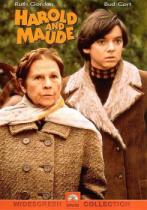Harold and Maude
 Year:
Year: 1971
Film Studio: Paramount Pictures
Genre: Comedy, Romance
Length: 91 Min.
DirectorHal Ashby (1929)
WritingColin Higgins (1941)...Written By
ProducerColin Higgins (1941)
Mildred Lewis
Charles Mulvehill
CinematographerJohn A. Alonzo (1934)
MusicCat Stevens...Song Writer
StarsRuth Gordon (1896) as Maude
Bud Cort (1948) as Harold
Vivian Pickles (1931) as Mrs. Chasen
Cyril Cusack (1910) as Glaucus
Charles Tyner (1925) as Uncle Victor
Ellen Geer (1941) as Sunshine Doré
Eric Christmas (1916) as Priest
G. Wood (1919) as Psychiatrist
Review When the term
‘cult classic’ is mentioned in regards to film most people think of
The Rocky Horror Picture Show or
The Texas Chainsaw Massacre, but my thoughts turn towards the best of all the
‘cult classics’,
Harold and Maude. Released in 1971 and directed by Hal Ashby, the film introduces us to Harold (Bud Cort), a privileged but neglected young man whose fascination with death has morphed itself into an endless series of staged phony suicides for the benefit of his mother (Vivian Pickles). He hopes that she will show him the attention he craves as she once did when an accident at school had Harold presumed dead. By now his mother is used to these
‘suicides’ and just shrugs them off without regard.
Harold’s other hobby is attending the funerals of people in the town where he lives. One day while attending one of these strangers’ funerals he meets Maude (Ruth Gordon), an octogenarian with a penchant for stealing any car that is available at the time, and whose outlook on life is completely foreign to Harold. While he is dour and sardonic and views the world through gray and gloomy glasses, Maude is buoyant and bubbly and can find the good in any situation that arises.
Harold is fascinated with her and slowly starts to fall in love with the rather eccentric woman, much to the chagrin of his mother, who has now decided that it’s time for Harold to marry. In one of the many hilarious scenes in the film she
‘helps’ Harold fill out a questionnaire for a computer dating service, and throughout the film we are introduced to the many suitors for Harold’s hand in marriage. Of course Harold will have none of this and stages phony suicides for these visitors also. In the end, Harold will learn that life is what you make of it and only through the pain of death will he finally learn this lesson.
Maude’s sincerity is best described by the following scene; As they sit in an abundant field of daisies,
Maude asks Harold, “What flower would you like to be?”
HAROLD: I don't know. One of these maybe.
MAUDE: Why do you say that?
HAROLD: Because they are all alike.
MAUDE: Oh, but they're not. Look, see... some are smaller, some are fatter...
some grow to the left, some to the right, some even have some petals missing.
All kinds of observable differences.
(Maude picks a daisy)
You see Harold,
I believe much of the world's sorrow comes from people who are this...
(describing the daisy in her hand)
...yet let themselves be treated as that.
(She waves her hand, gesturing to the overflowing field of flowers)
The scene then cuts to the two of them in a military cemetery, surrounded by endless rows of white, homogeneous headstones. As the camera pans back away from the couple, director Hal Ashby uses the metaphor of the daisies to point out, that behind every white tombstone is an individual, unique and full of promise, but whose life was squandered for the sake of political or religious ideologies. It is one of the most powerfully visual anti-war statements ever put on film.
This is not a film I would recommend to everyone, if you are a fan of Adam Sandler or Will Ferrell, it is not a film for you. If
This is Spinal Tap or
Kind Hearts and Coronets is more your style then you will enjoy the dark, dry, and cerebral wit that is at the heart of this screenplay. View it multiple times because you won’t catch every joke in one viewing, like fine wine it ages and matures with time. Hopefully you will come to appreciate it as much as I do; as I have it nestled in my top five films of all time.
Ratings Criterion5 Stars - The pinnacle of film perfection and excellence.4 ½ Stars - Not quite an immortal film, yet a masterpiece in its own right.
4 Stars - Historically important film, considered a classic.
3 ½ Stars - An entertaining film that’s fun or engaging to watch.
3 Stars – A good film that’s worth a Netflix venture.
2 ½ Stars - Borderline viewable.
2 Stars – A bad film that may have a moment of interest.
1 ½ Stars – Insipid, trite and sophomoric, and that's its good points.
1 Star – A film so vacuous, it will suck 2 hours from the remainder of your life.
½ Star - A gangrenous and festering pustule in the chronicles of celluloid.